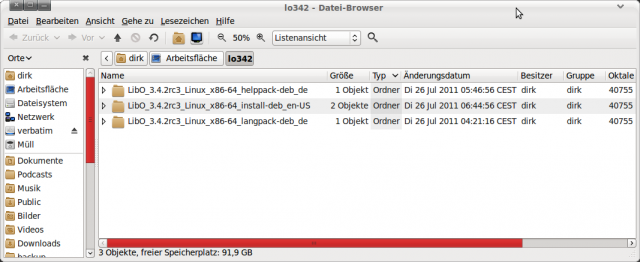Um auf einem Wirtsrechner mehrere Instanzen von unter Virtualbox laufenden VMs mit dem Wirt selbst zu starten und zu stoppen, brauchten wir entsprechende start-stop-Skripte. Fündig wurden wir im Forum von Virtualbox:
http://forums.virtualbox.org/viewtopic.php?f=7&t=34790
Eine Alternative sahen wir uns ebenfalls noch an, entschieden dann aber für das Skript von Nicolas Tessore. Trotzdem – wenigstens noch der Link: http://www.glump.net/howto/virtualbox_as_a_service
Das Skript von N.Tessore passten wir ein klein wenig bei Require-Start an und dokumentieren dies nun hier. Es läuft reibungslos auf einem Ubuntu Server 10.04 LTS 64 bit und Virtualbox 4.1 – für andere VBox- und Ubuntu-Versionen sollte es anpassbar sein:
#! /bin/sh
### BEGIN INIT INFO
# Provides: vbox-headless
# Required-Start: $syslog $vboxdrv $network
# Required-Stop:
# Default-Start: 2 3 4 5
# Default-Stop: 0 1 6
# Short-Description: Start VMs in headless mode.
# Description: This script runs VMs for the default VirtualBox
# user in headless mode. Make sure all VMs are using different
# RDP ports.
### END INIT INFO
# Author: Nicolas Tessore <n.tessore@gmail.com>
####
# VirtualBox settings
####
# The user which owns the VMs
VBOX_USER=username
# The list of VMs to run. Leave empty to run all registered VMs.
VBOX_LIST=““
# VirtualBox executables
VBOX_MANAGE=/usr/bin/vboxmanage
VBOX_HEADLESS=/usr/bin/vboxheadless
####
# End VirtualBox settings
####
# Do NOT „set -e“
# PATH should only include /usr/* if it runs after the mountnfs.sh script
PATH=/sbin:/usr/sbin:/bin:/usr/bin
DESC=“VirtualBox daemon“
NAME=vbox-headless
DAEMON=$VBOX_HEADLESS
DAEMON_ARGS=““
PIDFILE=/var/run/$NAME.pid
SCRIPTNAME=/etc/init.d/$NAME
# Exit if the package is not installed
[ -x „$DAEMON“ ] || exit 0
# Read configuration variable file if it is present
[ -r /etc/default/$NAME ] && . /etc/default/$NAME
# Load the VERBOSE setting and other rcS variables
. /lib/init/vars.sh
# Define LSB log_* functions.
# Depend on lsb-base (>= 3.0-6) to ensure that this file is present.
. /lib/lsb/init-functions
vm_init_list()
{
# get registered VMs
LIST_VMS=`sudo -H -u $VBOX_USER $VBOX_MANAGE –nologo list vms | cut -d ‚ ‚ -f 1 | tr -d ‚“‚`
# check for list of VMs
if [ -z „$VBOX_LIST“ ]
then
# all registered VMs for user
VBOX_LIST=$LIST_VMS
else
# check that VMs exist
for VM in $VBOX_LIST
do
case $LIST_VMS in
„$VM“)
continue
;;
*)
log_failure_msg „ERROR: VM ‚$VM‘ is not registered!“
exit 1
;;
esac
done
fi
}
# get uuid for vm
vm_get_uuid()
{
vm=$1
hwuuid=`sudo -H -u $VBOX_USER $VBOX_MANAGE –nologo showvminfo –machinereadable „$vm“ | grep ‚hardwareuuid=’`
echo $hwuuid | cut -d ‚=‘ -f 2 | tr -d ‚“‚
}
# control running vm
vm_ctrl()
{
sudo -H -u $VBOX_USER $VBOX_MANAGE –nologo controlvm $1 $2 > /dev/null 2>&1
}
#
# Function that starts the daemon/service
#
do_start()
{
vm_init_list
# Return
# 0 if daemon has been started
# 1 if daemon was already running
# 2 if daemon could not be started
RETVAL=0
# Start all VMs
for VM in $VBOX_LIST
do
VM_UUID=`vm_get_uuid $VM`
VM_PIDFILE=“$PIDFILE.$VM_UUID“
VM_DAEMON=“$DAEMON“
VM_DAEMON_ARGS=“$DAEMON_ARGS –startvm $VM_UUID“
log_action_begin_msg „Starting VM ‚$VM'“
# test for running VM
USER=$VBOX_USER LOGNAME=$VBOX_USER start-stop-daemon \
–start \
–quiet \
–pidfile $VM_PIDFILE \
–startas $VM_DAEMON \
–test \
> /dev/null
# VM already running
if [ „$?“ != 0 ]
then
# report VM is running
log_warning_msg „VM ‚$VM‘ already running“
[ „$RETVAL“ = 0 ] && RETVAL=1
continue
fi
# start VM
USER=$VBOX_USER LOGNAME=$VBOX_USER start-stop-daemon \
–start \
–quiet \
–pidfile $VM_PIDFILE \
–make-pidfile \
–background \
–chuid $VBOX_USER \
–startas $VM_DAEMON \
— $VM_DAEMON_ARGS
log_action_end_msg „$?“
# check if start failed
if [ „$?“ != 0 ]
then
# report error
log_failure_msg „Error starting VM ‚$VM'“
RETVAL=2
fi
done
if [ „$RETVAL“ -lt 2 ]
then
log_daemon_msg „VirtualBox daemon started successfully“
else
log_daemon_msg „VirtualBox daemon started with errors“
fi
return „$RETVAL“
}
#
# Function that stops the daemon/service
#
do_stop()
{
vm_init_list
# Return
# 0 if daemon has been stopped
# 1 if daemon was already stopped
# 2 if daemon could not be stopped
# other if a failure occurred
RETVAL=0
for VM in $VBOX_LIST
do
VM_UUID=`vm_get_uuid $VM`
VM_PIDFILE=“$PIDFILE.$VM_UUID“
log_action_begin_msg „Stopping VM ‚$VM'“
# try savestate halt
vm_ctrl $VM savestate
# stop daemon
USER=$VBOX_USER LOGNAME=$VBOX_USER start-stop-daemon \
–stop \
–quiet \
–retry=TERM/30/KILL/5 \
–pidfile $VM_PIDFILE
case „$?“ in
0)
log_action_end_msg 0
;;
1)
log_warning_msg „VM ‚$VM‘ already stopped“
[ „$RETVAL“ = 0 ] && RETVAL=1
;;
2)
log_action_end_msg 1
log_failure_msg „ERROR: Could not stop VM ‚$VM'“
RETVAL=2
continue
;;
esac
rm -f $VM_PIDFILE
done
if [ „$RETVAL“ -lt 2 ]
then
log_daemon_msg „VirtualBox daemon stopped successfully“
else
log_daemon_msg „VirtualBox daemon stopped with errors“
fi
return „$RETVAL“
}
#
# Function that sends a SIGHUP to the daemon/service
#
do_reload() {
#
# If the daemon can reload its configuration without
# restarting (for example, when it is sent a SIGHUP),
# then implement that here.
#
start-stop-daemon –stop –signal 1 –quiet –pidfile $PIDFILE –name $NAME
return 0
}
case „$1“ in
start)
log_daemon_msg „Starting $DESC“ „$NAME“
do_start
case „$?“ in
0|1) log_end_msg 0 ;;
2) log_end_msg 1 ;;
esac
;;
stop)
log_daemon_msg „Stopping $DESC“ „$NAME“
do_stop
case „$?“ in
0|1) log_end_msg 0 ;;
2) log_end_msg 1 ;;
esac
;;
status)
status_of_proc „$DAEMON“ „$NAME“ && exit 0 || exit $?
;;
#reload|force-reload)
#
# If do_reload() is not implemented then leave this commented out
# and leave ‚force-reload‘ as an alias for ‚restart‘.
#
#log_daemon_msg „Reloading $DESC“ „$NAME“
#do_reload
#log_end_msg $?
#;;
restart|force-reload)
#
# If the „reload“ option is implemented then remove the
# ‚force-reload‘ alias
#
log_daemon_msg „Restarting $DESC“ „$NAME“
do_stop
case „$?“ in
0|1)
do_start
case „$?“ in
0) log_end_msg 0 ;;
1) log_end_msg 1 ;; # Old process is still running
*) log_end_msg 1 ;; # Failed to start
esac
;;
*)
# Failed to stop
log_end_msg 1
;;
esac
;;
*)
#echo „Usage: $SCRIPTNAME {start|stop|restart|reload|force-reload}“ >&2
echo „Usage: $SCRIPTNAME {start|stop|status|restart|force-reload}“ >&2
exit 3
;;
esac
:
In diesem Pastebin liegt es auch noch rum, sollte Copy and Paste aus WordPress mal wieder zickig sein:
http://pastebin.com/4i8W0FB2
Mit Hilfe von
update-rc.d vbox-headless start 99 2 3 4 5 . stop 99 0 1 6 .
konnte das Skript dann zwar in die richtigen Ordner
/etc/rc2.d/S99vbox-headless
/etc/rc3.d/S99vbox-headless
/etc/rc4.d/S99vbox-headless
/etc/rc5.d/S99vbox-headless
eingefügt werden, aber – komisch, komisch – nicht an der 99. Stelle, sondern immer nur an der 20. Diese Anpassung musste also von Hand vorgenommen werden.
Das wirklich coole an N.Tessores Skript ist, dass es die VMs nicht herunterfährt, sondern bei einem Serverreboot schlicht pausieren lässt. So sind die VMs nach dem Start des Wirtsrechners sofort wieder da.



